How solar panel works in off-grid area.
Introduction of PV panel characteristics
- Definition
Generally, the main feature of the solar panels is to absorb sunlight and generate voltage and current. This source of electrical power is used in multiple applications including on-grid and off-grid solar systems.
Each PV panel has a nominal power, which is the power generated by the operation voltage level of the panel at the maximum power point under the standard ambient temperature (STC, standard test conditions, that is the atmospheric mass is 1.5, the ambient temperature is 25℃, and the optical radiation intensity is 1000W/m2).
The picture below shows the specifications of a sample solar panel.
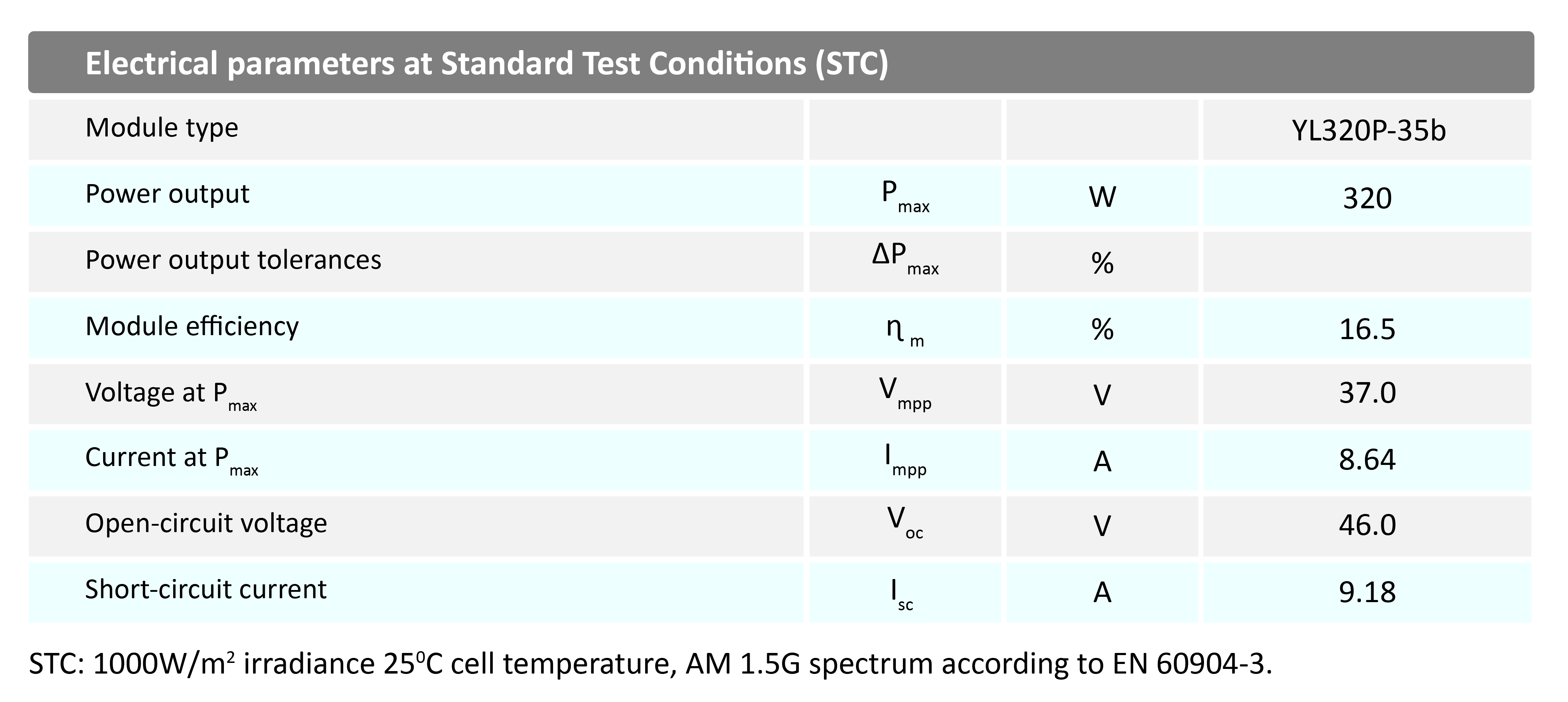
The I-V curve corresponding to this panel is shown in the figure below.
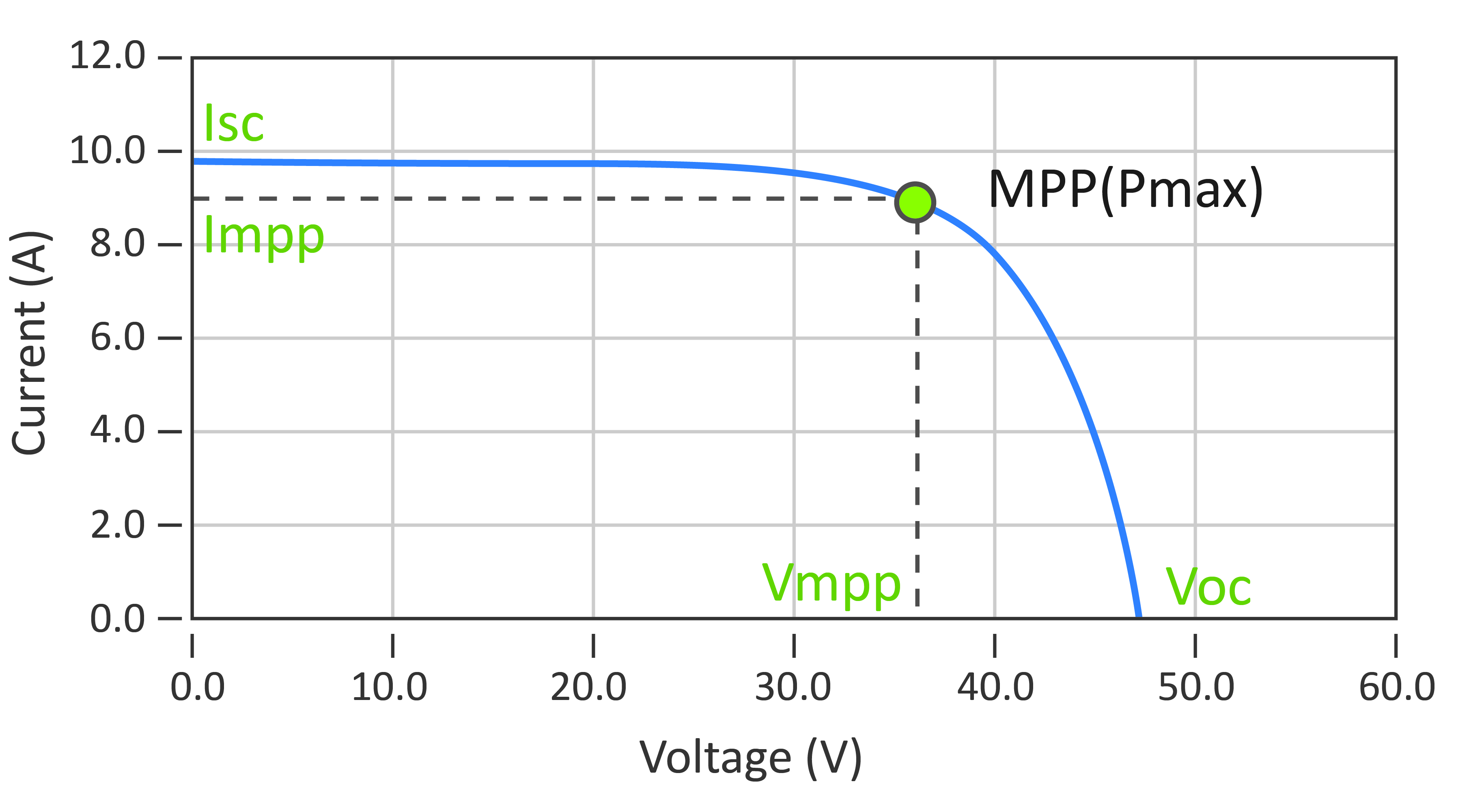
There are several basic parameters for solar panels, including rated power(Pmax), the efficiency(η), the open-circuit voltage(Voc), the maximum power point voltage(Vmpp), and the maximum power point current(Impp).
Here we will discuss each parameter in detail:
Rated Power(Pmax):
Represents the power generated by the maximum power point voltage of the panel at the standard ambient temperature.
Efficiency(η):
Represents the photoelectric conversion efficiency of the silicon wafer applied in the panel. For example, the efficiency of 16.5% represents that the silicon wafer can generate 165W of electric energy per square meter.
Here you can read more about efficiency.
Open Circuit Voltage(Voc):
Represents the voltage generated at the ends of panel electrodes, when the panel is open circuit at standard ambient temperature.
Short Circuit Current(Isc):
Represents the current generated by the panel when the positive and negative electrodes of the panel are connected to each other at the standard ambient temperature.
Maximum Power Point Voltage(Vmpp):
Demonstrates the operating voltage at the maximum power point of the panel at the standard ambient temperature.
Maximum Power Point Current(Impp):
Represents the operating current corresponding to the operating voltage of the panel at the maximum power point, when the panel is under standard ambient temperature.
Note:
According to the I-V curve of the panel, the different operating voltage of the panel corresponds to different currents and consequently different power rates. Therefore, the operating voltage of the panel determines the level of the power generated by the panel. Considering off-grid solar applications, this is a very critical issue because the voltage at which the system is working determines the efficiency of the whole system. PWM and MPPT charge controllers act differently regarding this issue.
The operating voltage of the panel is close to the voltage of the battery when using the PWM controller, and the operating current generated is close to Isc. However, the operating voltage of the panel is at Vmpp, and the corresponding operating current is at Impp when using MPPT controller. Since the Impp is approximately equal to Isc, Vmpp is greater than Vbat, so, the utilization rate of the panel is more efficient than the PWM controller when using MPPT controller.
Here, you can read an article entitled “MPPT vs PWM” to find out more about the key differences between MPPT and PWM charge controllers.
- Solar Panel Construction
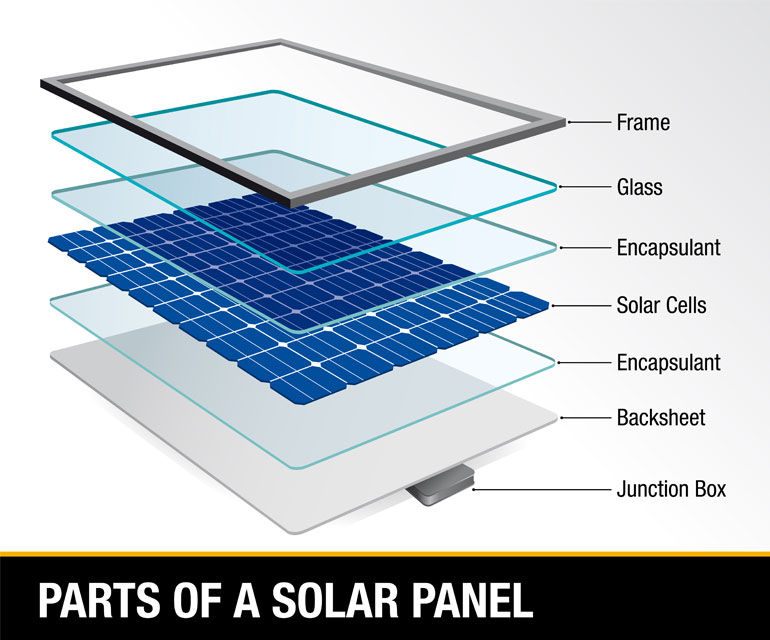
A complete solar panel is generally composed of a back sheet, EVA, crystalline silicon, tempered glass, aluminum profile frame, and junction box. (Major revision: We need pictures at each part to depict the concept. Without pictures it’s difficult to understand these concepts).
EVA(Ethylene-Vinyl Acetate):
Hot melt adhesives are polymer-based and are thermoplastic in nature leading to be solid at room temperature. These adhesives do not utilize water, or solvents in order to acquire their adhesive properties, which allows them a very fast set time, a long shelf life, and functionality in a wide range of temperatures.
In long term test proof, it achieves satisfactory results in solar cell package and outdoor use.
Tempered Glass:
Tempered or toughened glass is a type of safety glass, processed by controlled thermal or chemical treatments to increase its strength compared with normal glass. Tempering puts the outer surfaces into compression and the interior into tension. Such stresses cause the glass, when broken, to crumble into small granular chunks instead of splintering into jagged shards as plate glass (a.k.a. annealed glass) does. The granular chunks are less likely to cause injury.
In the wavelength range of the solar cell spectral response (320-1100nm), the light transmittance is above 91%, and the reflectivity of infrared light is higher than 1200 nm. The glass is also resistant to radiation from the solar ultraviolet light, and the light transmittance does not decrease. In other words, ultraviolet radiation doesn’t affect the light transmittance of the sun’s spectrum; since glass demonstrates resistance against the ultraviolet light.
Aluminum Profile Frame:
The tablet of the panel must have borders to protect the components and the connection between the components and the array of wafers. The border is composed of binders to seal the edge of the components.
Tinned Copper Strip:
Made by shearing or rolling of oxygen-free copper, all outer surfaces have a hot layer. The tin-coated strip is used for connecting cells in series confluence welding of solar cells in the production of solar modules.
Junction Box:
A box is soldered to the back lead of the component. Its main function is to connect and protect the solar photovoltaic module and connect the power generated by the solar cell to the external circuit, also conduct the current generated by the photovoltaic module. The junction box is generally composed of the box body, diode, conductor and connector(MC4). The protection rating for the connector(MC4) and junction box is generally IP65.
- Panel Type
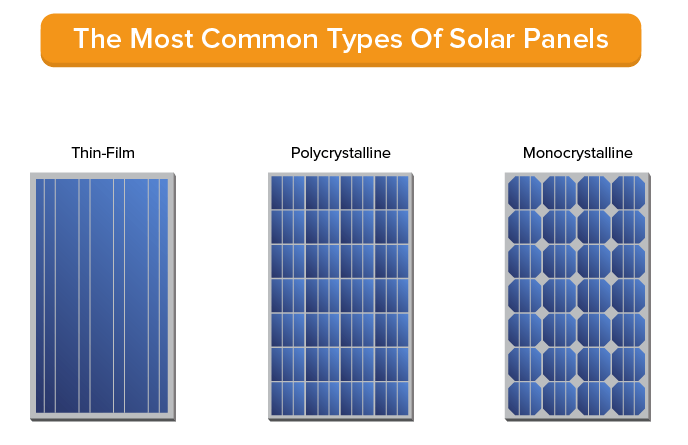
Monocrystalline Silicon
The photoelectric conversion efficiency of monocrystalline silicon solar cells is about 18% and a peak of 24%. According to the development of fabrication technology, the monocrystalline silicon costs similar amount to the polycrystalline silicon. Since monocrystalline silicon is generally encapsulated with tempered glass and waterproof resin, it is durable and has a service life of up to 15 years and a peak of 25 years.
Polycrystalline Silicon
The fabrication process of polycrystalline silicon solar cells is similar to the monocrystalline ones. However, the photoelectric conversion efficiency of polysilicon solar cells is lower than monocrystalline solar cells, which is about 15%. In terms of fabrication costs, the polycrystalline solar cells are cheaper than monocrystalline solar cells, it’s simple to manufacture the materials and save power consumption. Therefore, the total production cost is lower, so it has been greatly developed in recent years. In addition, the service life of polycrystalline solar cells is shorter than the monocrystalline solar cells which have better CPI.
Thin Film
The fabrication method of amorphous solar cells is completely different from the monocrystalline and polycrystalline solar cells. The process is greatly simplified with lower silicon materials consumption and power consumption. The main advantage of amorphous solar cells is that they can generate electricity in weak light conditions. However, the main problem of amorphous solar cells is the low photoelectric conversion efficiency, which is about 10% of the international advanced level and it’s not stable. Also, its conversion efficiency decreases by the long cycles.
- Main Characteristics
As mentioned above, the specification parameters are all the values tested at the standard environment temperature, but in the practical applications, most of the temperature condition is not close to the standard.
Light Intensity Characteristic
The following figure shows the different I-V curves corresponding to the panels under different light intensities. When the light intensities vary from 200W/m2 to 1000w /m2, the current also varies resulting in different output power levels.

As it’s shown in this figure, when the light intensity is changed, the panel’s open-circuit voltage (horizontal axis) basically does not change, but the short-circuit current (vertical axis) will have obvious changes with the light intensity, resulting into changes in output power of the solar panel. Therefore the panel will always have a high open-circuit voltage, but the power generation will be affected by the sun’s exposure intensity.
Temperature Characteristics
As shown in the figure below, the I-V curve of the panel, changes at different temperatures. It can be seen from the figure that when the ambient temperature is low (T4 is the lowest), the panel’s open-circuit voltage is higher compared to the standard conditions, and the short-circuit current has a small increase. When the ambient temperature is higher (T1 is the highest), the open-circuit voltage is lower and the short circuit current has a small decrease.

Normally, the temperature variation coefficient of the panel’s open-circuit voltage is about -3% (25℃ as the reference). Taking this specification as an example, if the temperature is -20℃, the open-circuit voltage should be higher than standard conditions based on the theory explained before. The amount of increase can be calculated as a 3% increase for each 1℃ temperature decrease; so for 45℃ temperature decrease, the open-circuit voltage level’s change rate will be (45℃*3%=1.35). so the new voltage level would be the standard open-circuit voltage multiplied by 1.35.
Regarding charge controllers in off-grid solar applications, changes in the ambient temperature will change the open-circuit voltage, resulting in a varying maximum power point. Therefore to obtain the maximum power available from the solar panels, the MPPT point should be calculated continuously in different situations. As an example, the maximum open-circuit voltage of the Tracer4215BN controller is 150V. IF three panels are connected in series together, at -20℃, the open-circuit voltage of the arrays will rise to 156.63v (52.21*3). If the temperature decreases, the voltage will grow continuously until the charge controller limits the input due to the limitations of the input voltage. Similarly, if the controller is used in a high-temperature environment such as Africa, the open-circuit voltage will be lower than 138V. However, there are extra limitations for ambient temperature and the controller will stop functioning in higher temperatures.
- Average Sun Exposure Peak Time
The peak sun exposure time refers to the time when solar radiation reaches 1000W/m2 (scales in scientific format), but the time from sunrise to sunset is relatively long, and the solar radiation intensity of each time period is different, most areas only have 1-2 hours of radiation reaching 1000W/m2
1000W/m2. Therefore, in the application of the photovoltaic systems, the average peak sun exposure time refers to the time after the average of total radiation amount obtained during the day by 1000W/m2
1000W/m2, as shown in the figure below.
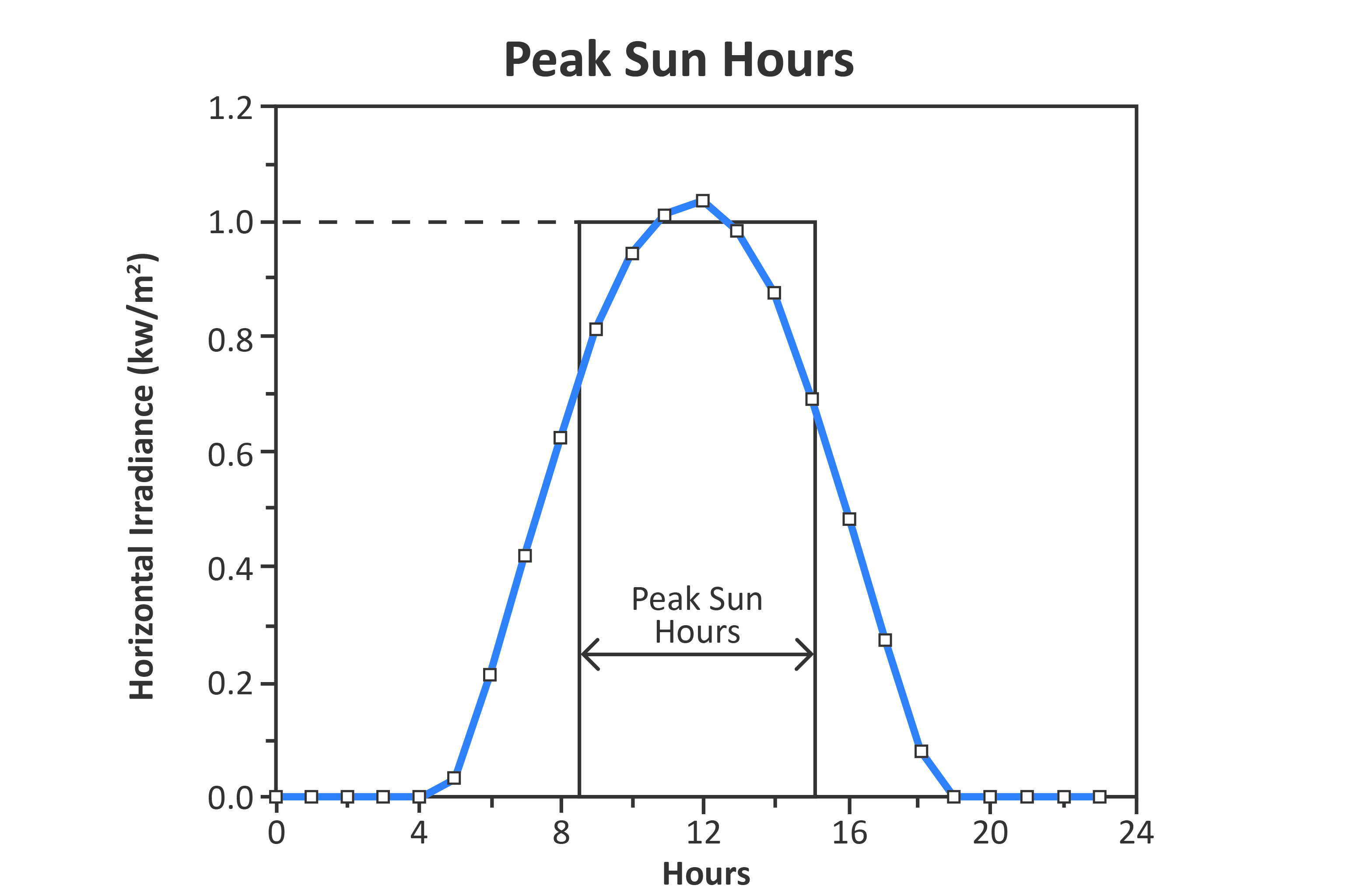
- Application
Brief Introduction
Solar cell module is the core of the solar power generation system, converting the sunshine into electricity.
In an off-grid system, the solar cell module generally charges the battery and supplies power to the load through the solar controller. For AC consumers, the inverter needs to be added to achieve AC output power supply.
The configuration size of solar cell modules generally depends on the daily electricity consumption of the load and the local environment and other factors. The daily electricity generation of the solar module should ensure to meet the daily electricity consumption of the load and should have enough energy to charge the battery.
In general, the nominal power of the module is the power generated in the standard environment, but in the practical environment, the power generation efficiency of the panel is affected by many factors, such as surface dust, atmospheric transparency, temperature, installation angle and so on. Therefore, there will be certain losses while installing the panels. The loss coefficient is generally about 0.7-0.8. Of course, it also depends on the practical application environment. If the light is perfect, the loss coefficient could be a little bit lower.
Connection
In practical applications, the connection modes of the panels are generally series and parallel. MC4 connectors are employed to connect the panels in series while for parallel connections some other connectors such as parallel head (MC4T) or photovoltaic manifold box should be utilized.

When conducting series and parallel operation of panels, we must pay attention that only the panels with the same specification can be used in series or parallel connections, and the panels of different specifications cannot be connected in series or parallel. Otherwise, there will be a bottleneck effect, reducing the power generation by the panel or damaging the panels. For example, if the panels with different current specifications are connected in series, the power generation current will be reduced, and the heat of the panels with lower current may also cause the risk of damage. If the panels with different voltage specifications are connected in parallel, there will be a reverse irrigation current from the high-voltage panel to the low-voltage panel.
In addition, in practical applications, lightning protection and air opening are required for connecting the panels, and the aluminum profile shell of the panels needs to be effectively grounded to ensure the reliability of the system.
- Tips about solar panels and off-grid systems
a. If the load control mode of the controller is in light control mode, the load will not be turned on during cloudy days, because the open-circuit voltage of the panel is still high.
b. Based on the power and efficiency of the panels, the area and capacity of the battery can be estimated. Only the power and efficiency need to be divided by the approximate size of the panel.
- FAQ
- Do solar panels generate electricity during cloudy, rainy, or snowy days? What about during night time?
Answer: According to the characteristics of the battery, whether it is cloudy or rainy, the open-circuit voltage of the panel will not change too much, but the short-circuit current will be affected, and the power generation will also be affected. At night time, the open-circuit voltage and short circuit current are about zero.
- What happens if solar panels are short circuit?
Answer: According to the I-V characteristic curve of the panel, if the panel runs in short circuit, the Voc is 0 and the current is Isc, so the power generated by the short circuit is close to 0W, which will not cause damage to the panel, so the panel short circuit will not have any impact. However, it is recommended not to short-circuit the panels as much as possible.
- How to fast calculate whether the panel capacity meets the system application?
Answer: Assuming that the daily power consumption of the load is QL, the comprehensive conversion efficiency of the system is 0.88, the photovoltaic cell loss coefficient is 0.75, the system voltage grade is V, and the peak sun exposure time is H, then the photovoltaic cell capacity is at least PPV=QL/0.88/0.75/H/V. In the detailed calculation, we need to consider the daily surplus energy to charge the battery, to ensure that the battery can be full. Read this article about “How to size off-grid systems” and use this “Web-based tool” for easily calculating the size fo your off-grid system.
- Considerations of solar panels while selecting an MPPT or PWM charge controller:
PWM Controller
For PWM controller, two parameters should be considered while selecting the solar panels. The first is the open-circuit voltage of the panel to ensure that the open-circuit voltage won’t exceed the specified voltage of the controller. The second parameter is that the short-circuit current of the panel should not exceed the nominal current of the controller.
For the PWM controller, the amount of generated power can be calculated by the product of short-circuit current and the voltage level of the system, theoretically.
Note that for series panel arrays the short-circuit current is the same amount while the voltages of the panels will be added. However, for parallel connection, the voltage level will be constant while short-circuit currents will be added to each other.
MPPT Controller
For the MPPT controller, two parameters need to take into consideration regarding the solar panels. First is the total power of the solar array should not exceed the nominal rated power of the controller. The second is that the solar array open-circuit voltage should not exceed the nominal maximum allowed open-circuit voltage of the controller.
- What does the temperature characteristic of the panel mean?
The level of open-circuit voltage acts reverse as the temperature; it means as the temperature decreases, the open-circuit voltage increases. So normally, the temperature coefficient is about -3 percent.
For cold climate conditions, the maximum allowed open-circuit voltage of the controller should be noted, since lower temperatures will increase the level of open-circuit voltage and when this level exceeds the maximum voltage of the controller it may cause damages to the whole solar system.
- Under the nominal environment, the rated power of the panel is 300W, but the actual power generation is 100W, where did the other 200W go?
Answer: According to the I-V characteristic curve of the panel, Pmax of the panel refers to the maximum power generated when the working voltage of the panel works at Vmpp. The panels will not generate the maximum power at any given time. Because it depends on the operating voltage of the panel, different operating voltages correspond to different operating currents, generating different power levels. Therefore, when the practical generating power is 100W, it indicates that the operating voltage of the panel is not the Vmpp. Therefore, the amount of 200W power is lost or consumed by the panel, but the light energy is not converted into electricity. The panel only converts 100W of electricity, and the other 200W is still light energy.

Dein Beitrag gefällt mir. Es enthält viele interessante Details. Was ist mit Glücksspielen? Spielen Sie gerne Casinos um Geld?